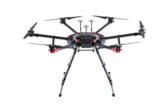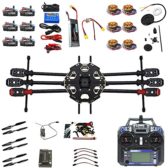The Best Hexacopters: Drones with 6 Motors
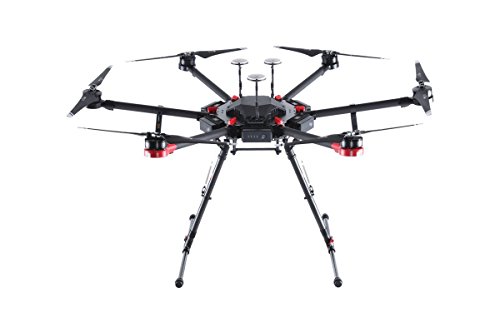
DJI Matrice 600 Pro
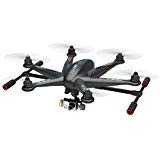
Walkera Tali H500 RTF6
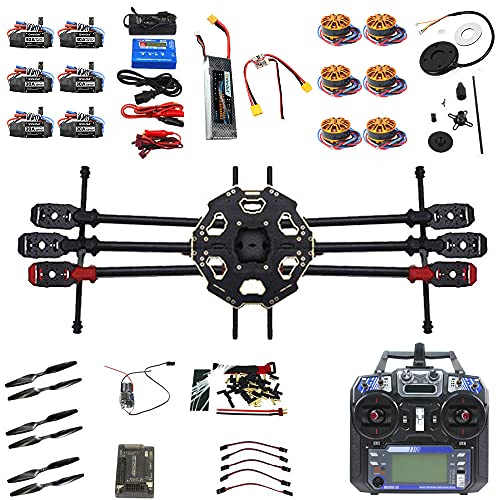
Tarot 680Pro Kit
Whoever said that less is more certainly wasn’t talking about drone motors. Unlike their four-motored cousins, hexacopter drones are usually faster, more durable, and offer much more safety and stability.
There are always exceptions to this rule, of course, but the above is true in a large number of situations.
Because of the geometrical demands of the design, there has been no attempt to make hexacopters small and nimble. This is why developers and manufacturers focused on making the devices more durable and with better flying time.
When it comes to professional drones — we’re talking big, heavy duty, costly investments — this is typically the best way to go. For example, if you want to fly a heavy DSLR camera around then you won’t be thinking about the size regardless of the blades. And with six of them, you will not only have the picture as stable as possible but a safeguard if one of the blades fails.
The Best Hexacopter Drones
There is a wide range of products that can be regarded as the best hexacopter drones, and we’re going to take a look at them in detail below. As the term ‘best’ often depends on the user, they don’t need to be much alike and can host different features.
On the smallest side, there are fun drones that don’t cost a lot and can be a great way to enter the market. For these drones, the added stability will mean a more gentle learning curve for novice drone pilots.
In the middle of the market, there are comfortable camera drones. These models will usually use their added strength and stability to feature better video cameras.
Finally, there’s the top of the hexacopter market. If you are a seasoned professional that needs to have an eye in the sky with heavy and delicate equipment, a hexacopter could well be the way to go.
We may receive compensation on qualifying purchases via our links. This does not change how we review items. For more information, please read our affiliate disclosure.
One of the top of the range drones that money can buy. Absolutely perfect for professional projects like surveying.

- Flight Time: ~25 to ~45 minutes (depending on the payload)
- Charge Time: ~6×180 minutes
- Range: 5000m / 3.1mi
- Remote Controller: WiFi 2.4GHz with 5.4Ghz video transmission (included in the set)
- Camera: FPV 2K Camera with 12MP
- Live Video Transmission Range: 5000m / 3.1mi
- Weight: 10Kg / 22lbs
- Working Temperature: Depending on the camera
- Rated for outdoor use
The worst of jobs always need the best of tools, and that is the case with surveying. The Matrice 600 Pro will certainly become the industry standard when it comes to professional drones.
The drone itself is all about reliability, stability, and versatility. The six blades offer ideal flight in most conditions, and the redundancy system is valuable to keep your drone in flight in the case that some of the modules get damaged.
This security is essential, as the M600 Pro will use your professional camera equipment. The drone will ensure that that equipment doesn’t get damaged in any way.
The gimbals will allow all types of cameras to be installed, including those that can measure levels and coordinates.
By using the DJI Fly app, you will be able to control the drone through a tablet or smartphone, accessing all of the information you need directly. With smart AI features, this drone can do most of your work for you.
With the six batteries on the drone itself and the one dedicated to the gimbal and the camera, you can expect over 25 minutes of flight even with the heaviest of equipment.
The drone can lift to 35lbs, and can fly longer with lighter equipment. With a good surveyor camera, this can well past the 30-minute mark.
Finally, the device itself is very easy to fly.
+ Pros
- Cons
With a high range and a wide variety of features, there is little that this drone can’t do.

- Flight Time: ~25 minutes
- Charge Time: ~210 minutes
- Range: 2000m / 4000ft
- Remote Controller: WiFi 2.4 & 5.8 GHz (included in the set)
- Camera: 3-axis gimbal iLook HD Camera @13 MP
- Live Video Transmission Range: 1500m / 1640.4ft
- Weight: 1360g / 3lbs
- Carry capacity: 620g / 1.3lbs
- Working Temperature: ~0°C to ~40°C
- Rated for outdoor use
With the H500 we are entering the range of high-end hexacopters, where this type of design really starts to shine.
The controls are quite intuitive and you can see everything from a 5-inch screen in real-time. And with 12 channels available there is little chance that your connection may be interrupted.
Using a versatile 3-axis gimbal camera, this drone can record in all directions in Full HD with 30 frames per second. As all hexacopters, the added stability means that you don’t need to lower your resolution to get the best picture.
Additionally, this Walkera can stay in the air for up to 25 minutes, giving you more than enough time to record everything you need. And with more than 3000 feet of range, those panning shots can last for quite a while.
+ Pros
- Cons
The Tarot can correctly read into your future and it sees a lot of hours spent happily building and flying a drone.

- Flight Time: ~25 minutes
- Charge Time: up to 240 minutes
- Range: ~1500m / 4920ft
- Remote Controller: WiFi 5.8 GHz (included in the set)
- Camera: N/A or External
- Live Video Transmission Range: N/A
- Weight: 1100g / 38.8oz
- Working Temperature: -5°C to ~ 40°C
- Rated for outdoor use
This heavy-duty DIY set can transform into various types of drones, depending on how much you want to put on it.
It comes with a full set of brushless motors that bring a lot of lift, allowing the finished set to carry some serious equipment. Otherwise, you can opt for a smaller payload, prolonging the flight time.
Each motor has its own battery, which both increases the balance of the drone and the security of anything you might be carrying. As any hexacopter can fly with only four blades working, it creates redundancy in case of a problem.
If one of the blades gets damaged, the whole drone can safely land with only five blades, keeping any cargo you have safe and sound.
+ Pros
- Cons
Whilst this is slightly gimmicky, it does boast a variety of good features for a low-priced hexacopter.
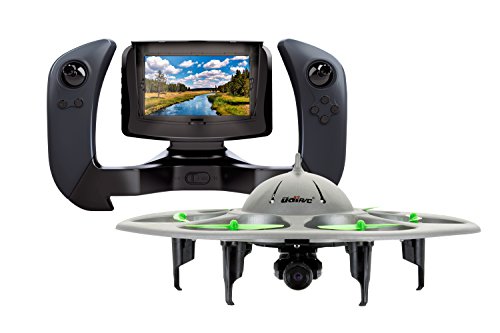
- Flight Time: ~7 minutes
- Charge Time: ~60 minutes
- Range: 100m / 330ft
- Remote Controller: WiFi 2.4 GHz (included in the set)
- Camera: 2MP 120° Wide Angle
- Live Video Transmission Range: 60m / 200ft
- Weight: 98 g / 3.4oz
- Working Temperature: -10°C to 40°C
- Rated for indoor and outdoor use
The truth is out there. And, with the U845’s camera, you will be able to go and check it out.
While the saucer design is mainly emphasized for laughs, it also has several advantages compared to the open models. Primarily, the blades on the Voyager are protected from any impact from the sides.
Also, if you bump the drone there will be little chance to damage the camera placed in the center. This way, the camera can be slightly bigger and more advanced than it would be on similar quadcopter models.
The lifting capabilities of the Voyager are also significant and even slightly increased by the design. Even though it can’t go really fast, the stability will make it easy to fly, both in strict FPV and in ‘headless’ mode.
Finally, the controller is quite responsive and allows for quick adjustments and panning shots from the drone’s HD camera. Not only does this allow for good quality footage, but it also makes the FPV flight more enjoyable and streamlined.
+ Pros
- Cons
This very cheap hexacopter is a good option for those just starting with drones. Unlike most affordable drones, it comes with a set of features that will assist you when taking flight.
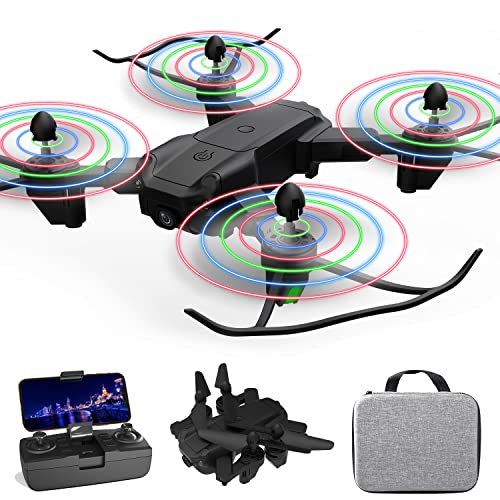
- Flight Time: ~10 minutes
- Charge Time: ~120 minutes
- Range: 100m / 330ft
- Remote Controller: WiFi 2.4 GHz (included in the set)
- Camera: N/A
- Live Video Transmission Range: N/A
- Weight: 520 g / 18.34oz
- Carry capacity: N/A
- Working Temperature: 0°C to ~ 40°C
- Rated for indoor and outdoor use
The combination of its six fairly strong blades and the 6-axis gyro positioned in the middle, it is very stable. It will resist some stronger winds and won’t drop inside pressure bubbles.
Additionally, it is fairly easy to take off and land, especially when using the ‘return home’ button.
As there is no camera function, the 300 feet of range is more than enough to have a lot of fun while exploring drone piloting. Because the drone works in headless mode, it is not important to remember the positioning at all times.
The flight time is slightly less than 10 minutes. This is good considering the low weight of the drone and the affordable price. There is a slight loss when it comes to speed, but nowhere near for a new drone pilot to notice.
Finally, the drone is quite durable and can sustain lapses when it comes to landing or hitting a solid object during flight. The only thing that might happen if for one of the blades to fall off, where you can fly the drone back to you and go look for the blade in your own time.
+ Pros
- Cons
If you don’t have the budget for a premium hexacopter, you can always make one from a kit like this.
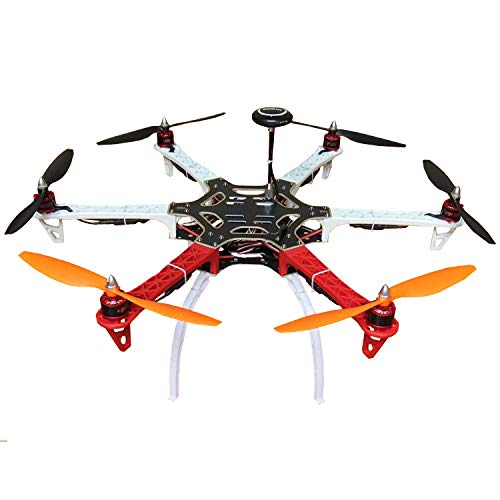
- Flight Time: depends on the battery
- Charge Time: N/A
- Range: 1000m / 3300ft
- Remote Controller: WiFi 2.4 GHz (not included in the set)
- Camera: N/A
- Live Video Transmission Range: N/A
- Weight as shipped: 320 g / 11.3oz
- Working Temperature: -10°C to 40°C
- Rated for outdoor use
If you want something done, you need to do it yourself.
Also, making a drone is very fun and can end up being a passion on its own. It is amazing seeing something you patched up at home taking flight for the first time. Not to mention that drone construction is an amazing family activity.
The F550 is somewhat if a collective term for a modern lineup of hexacopter chassis. Multiple manufacturers agreed on the design similar to the DJI Matrice and took it as a base to attach their own parts and add their twists.
The Hobbypower came out as one of the optimal arrangements for this type of drone. Their parts combine versatility and durability at a reasonable price. While some corners were cut to reduce the price tag, all of them can be added later.
The beauty of this drone is that you can always add something new later if you think you need it.
The motors provided on this model are very strong and can lift quite a bit. The body is extremely durable and will survive everything but the worst of crashes.
Finally, with the maximum current on the ESC allowing for up to 35 amps, you can place some serious batteries in this hexacopter, allowing for either amazing speeds or very long flight time.
+ Pros
- Cons
Hexacopter Buyer’s Guide
Because they are not the norm, the hexacopter market has been filtered and left with predominantly high-quality models. By simply knowing what to look for, it will be easy even for a novice to find a good drone.
The most important thing to remember is that some of the rules which govern quadcopters are not applicable when switching to six blades. Quick turns and stunts will be changed by stability and durability.
Finally, many of the hexacopters are not defined by the features they have on their own. Rather, their increased carry capacity allows them to lift the gear needed for a task. This makes the best hexacopters prized possessions of many professionals worldwide.
Why is Six Better than Four?
It is outright logical that more blades will equal more lift. But, what many people don’t understand is that it is not a simple addition. The 360-degrees of lift create a pressure imbalance between the air around the drone and underneath it.
This difference creates a vacuum, pushing even more air than the blades would alone, allowing for the drone to carry more weight with fewer rotations.
The domino effect continues, as a lower blade speed requires a weaker motor, which further requires a smaller battery, putting the overall weight of the drone down significantly.
Additionally, the pressure bubble keeps the drone very stable. If all blades are working at the same speed, the aircraft will always be aligned with the center of gravity.
This sacrifices some of the maneuverability but grants a lot in return.
Forget Portability
With modern quadcopters, we have seen a lot of designs that feature retractable or foldable wings. With a hexacopter that is not as possible. Even with models where the wings can be folded like an umbrella, the final form is not nearly as compact.
The smallest models will be able to fit in larger glove compartments or special duffle bags. But as you go larger you will need geometrically more space. The largest hexacopter drones will require a pickup truck, or a fairly large van to transport.
If you are deciding on this type of drone, make sure you have enough space to carry it around. While they are not necessarily heavy, they are almost always bulkier than their four-bladed counterparts.
Stability vs. Speed
While for some drone pilots this exchange will spell a deal-breaker, for others it will be the main selling point. Six blades will always be slower than four, all other things being equal.
Simply, because the hexacopter wants to stand upright, it will rarely gain enough tilt to zoom through the air.
This drawback does influence turning as well. But, since all directions are the same for the drone, it can strafe in all directions as quickly as it can move back and forth.
Because of this natural difference, all of the best hexacopter drones come with ‘headless mode’ as their default. Even with camera drones that allow for FPV flight, you will find yourself gliding to the side, disconnected from where you are looking at.
More Power Means More Utility
Even though six-bladed drones can be used as a good entry point to the drone market, their main advantage lies in their utility. Better lift to weight ratio means that hexacopters can carry more equipment, or even cargo if needed.
Most videographers, including the top-notch Hollywood crews, use hexacopters to get those pristine aerial shots we all see in movies. As the big drones can easily carry a large movie camera, it becomes the ideal choice.
Other professionals might also find the capacity and stability of a hexacopter ideal for their business. Any activity that demands a drone to be at a single place longer will find this type ideal.
In some cases, such as surveying or night-time photography, the extended exposure of the lens will provide a much better picture than any other drone. In this regard, a hexacopter is more akin to a tripod than a flying contraption beaten by the wind.
Battery Capacity
The difference in design gives hexacopters a huge benefit, as there is simply more space to place the batteries, and they don’t need to be as dense.
In some of the best hexacopter drones, the battery will even be placed for every wing separately. This will give the pilot more room for error and more time to retrieve the drone once the batteries are starting to drain.
When it comes to carrying valuable equipment or cargo, this separation can mean a world of difference.
While hexacopters are more energy-efficient than their four-bladed counterparts, this doesn’t always translate to longer flight time. This is due to much heavier attachments used by these drones that drain the battery faster.
Additionally, it is possible to overheat both the engine and the blades, as the cooling systems can never be as good as in a quadcopter.
Thankfully, any failure on the blades or motor will not force the machine to spiral out of control and fall down. Rather, if a blade fails, the drone will slowly lose altitude and usually hit the ground fairly gently.
Battery Strength
Unlike quadcopters, these drones don’t need to have as strong batteries.
If they carry a single battery, they will have more than enough lift even with lower RPM to fly the drone normally. Due to their innate features, almost any modern battery will function perfectly on this type of drone.
If they are larger and require more juice, there will also be multiple places for a battery, solving this issue.
Same as any drone, hexacopters will benefit from having stronger batteries that can give more power to the motors. But, as there are virtually no racing hexacopters that would need this specifically, most users will not be able to tell the difference.
Installed Redundancies
The most important, and the most obvious, redundancy feature when it comes to hexacopter components are the additional blades. The fact that you can still fly even if you lose a blade means a lot to your sensitive equipment and the budget financing it.
But, larger models can host even more repetitive systems that safeguard the drone from any mishaps.
Multiple batteries, or more GPS antennae, will enable you to finish important work before going back for repairs or adjustments. And if you are doing something like reporting or surveillance, the ability to stay just a minute longer can be everything.
Are Hexacopters Better Than Quadcopters?
As always, it depends on the intended use. Drones are bringing a revolution to how certain industries are behaving, and there are too many options to make even an educated prediction.
If your business demands stability and security, a hexacopter is quite probably the way to go. If you need speed and maneuverability, you should stick to the quads.
The biggest benefit of hexacopters is that they can carry more weight compared to their size. So, if you need to take heavier equipment to the air, this will be your pick. Anything from cinematography to surveying is currently being done with hexacopter drones.
In the end, only you can know your specific industry needs. Weighing all the pros and cons of the product will allow you to find the best solution that can further develop your business.
Considering Design
Drones are fun. And something used for entertainment should also look good and have a modern design.
But, when it comes to hexacopters, a particular design has more to do with function than their perceived beauty. They’ll still look cool but also work differently depending on the design.
Enclosed blades will be more secure, and have more stability, but speed and range would be reduced.
Similarly, larger hexacopter drones tend to be reduced in their casing and similar systems to add to the carry weight.
Conclusion
While a hexacopter might seem like an oddity, there are multiple good reasons why you should opt for six blades instead of four. And, for the best hexacopter drones on the market, these reasons become even more important.
If you are a professional and need your drone to be stable and reliable at all times, six is the way to go. Also, you might want one because they are arguably easier to fly.
Finally, all drones are fun to fly around, and if that is the value you are looking for you will not be sorry with any of the models.

